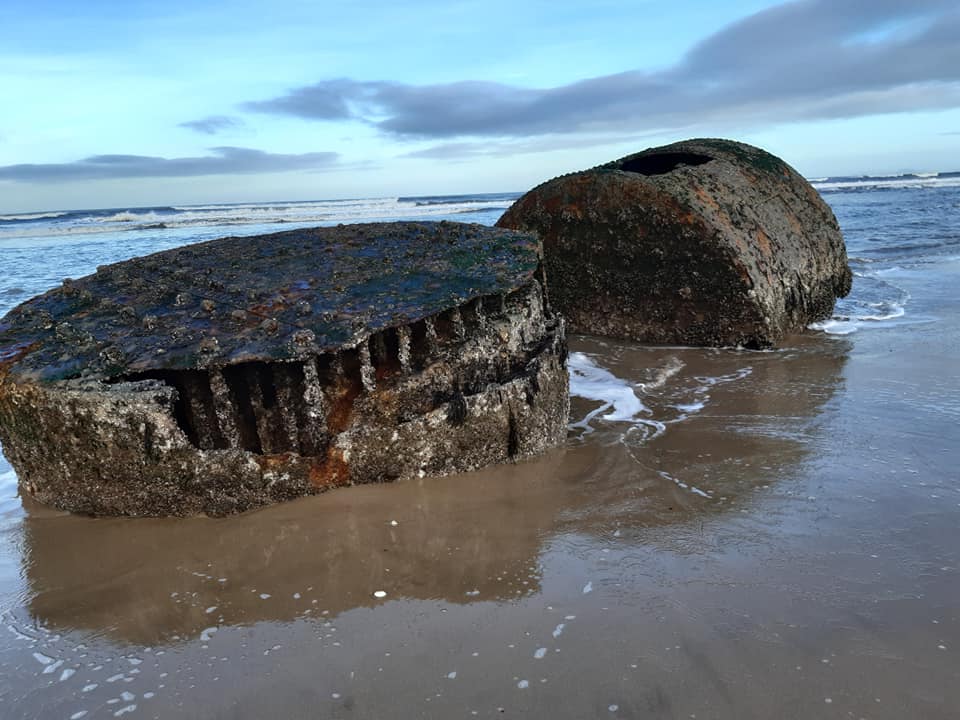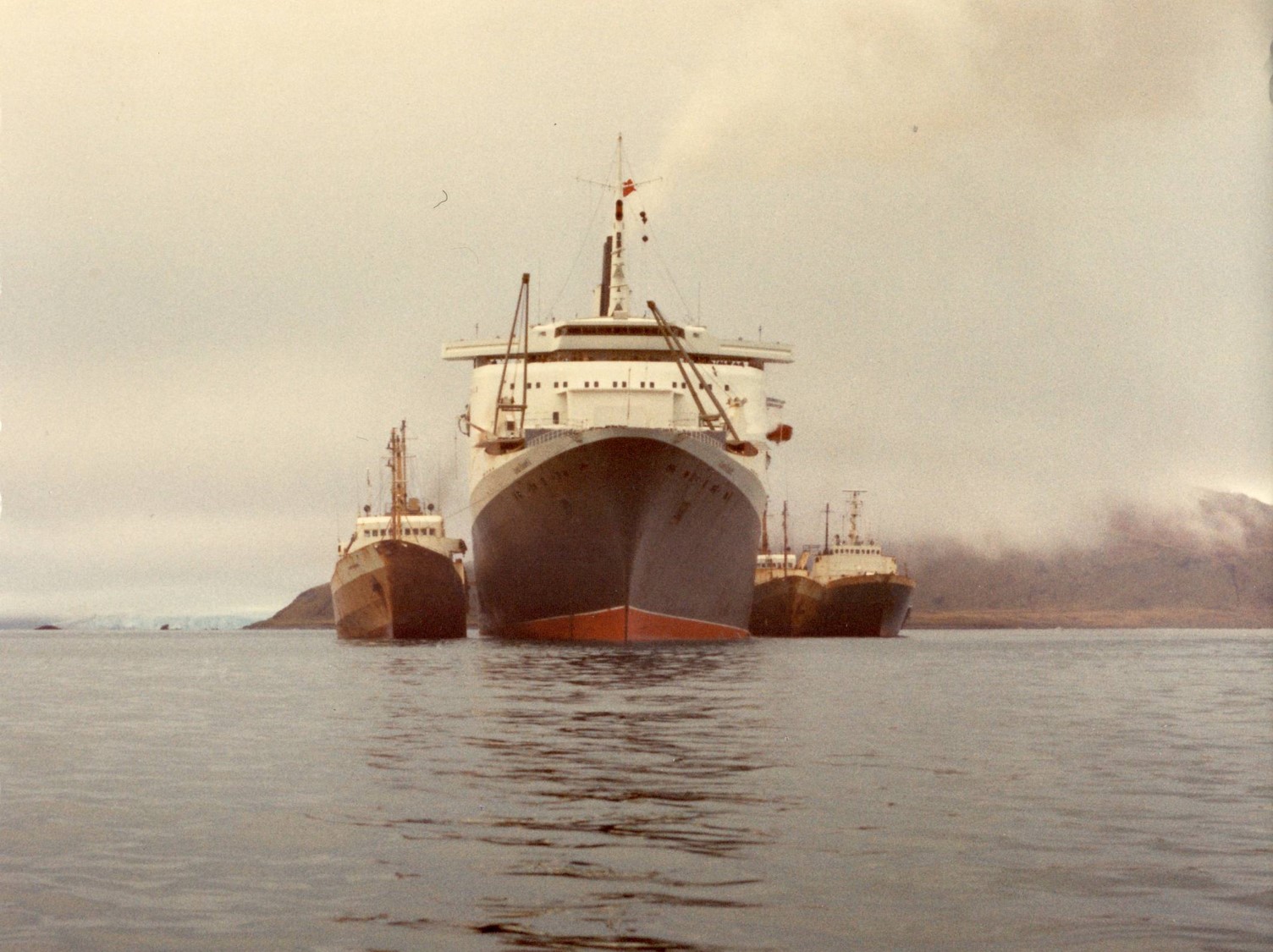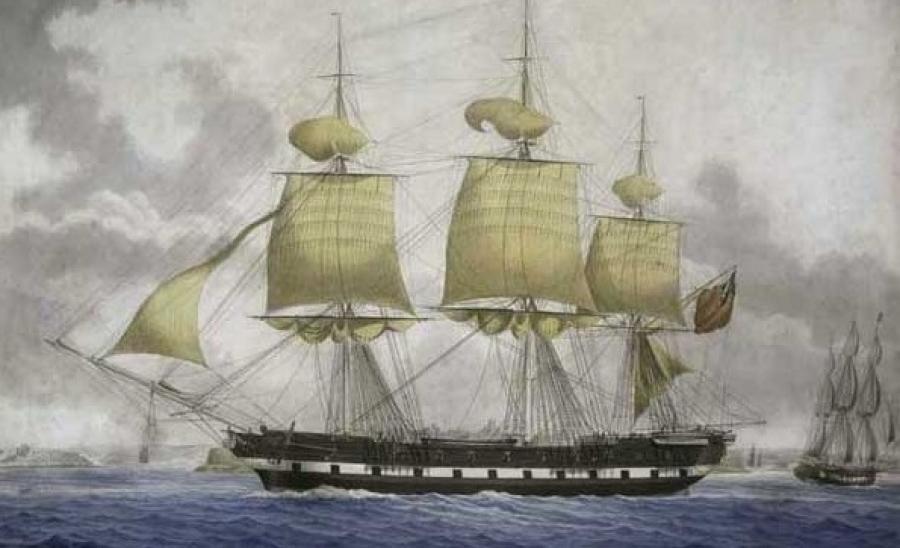Blaydes researcher Dr Robb Robinson is investigating the history of the Yorkshire coast for a forthcoming book, and has uncovered the story of the wrecking of the Hull trawler Diamond. Here he traces the lives of its crew and their rescuers, offering a fascinating window into the social history of this coastal county during the first half of the twentieth century.
If you walk along the shore close to Speeton Cliffs north of Filey on the Yorkshire coast you can encounter the remains of the Hull trawler Diamond which was wrecked there in January 1912, one hundred and ten years ago.

The crew of the Diamond were saved when their vessel hit the rocks that day, but not all sailors whose ships have been wrecked on that stretch of coast have been as fortunate. A fair number of steam trawlers came to grief under Speeton Cliffs over several decades as did countless other vessels of all descriptions across many centuries. Each vessel and crew have their own and often long forgotten narratives, but family historian Peter Chapman and I have traced the lives and times of the Diamond’s crew; all lived in and around Hull and their individual stories encompass not only the shipwreck and its immediate consequences but also aspects of vital war-time naval duties, service misconduct, imprisonment, marital problems as well as something of the unremittingly harsh tithe still demanded by the ocean to this day from fishermen and their families for the fish that they catch; seafarers so often left with no grave but the sea.
But first, a little about the trawler. The Diamond had been built in 1891 on Clydeside by the shipbuilders Mackie & Thompson and was owned by the Kingston Steam Trawling Company. The trawler had sailed from Hull on the 29th December 1911 and after fishing in the region of the East Fladden grounds, about 300 miles NNE of Spurn Point, until 2am on 8th January 1912, the skipper, forty-one-year-old Thomas Davis, set a SSW course for the homeward voyage. During the return trip the trawler ran through SSE gales and when the bosun, George Wood, came on watch at 6am on the morning of the 9th the Diamond was still going full speed on its original course. Dawn had yet to break, the weather conditions and visibility were poor but after ten minutes Wood saw what he at first thought was a heavy snow shower but soon afterwards glimpsed breakers straight ahead – it was not snow he had seen but actually the gaunt chalk spectre of Speeton Cliffs. He shouted to the hand on the helm to turn hard a starboard. The skipper, soon on deck, ordered hard astern. It was too late, within ten minutes the Diamond struck heavily on the shore, the chief engineer, John William Ethell, recalling afterwards that the inrush of water soon extinguished the boiler fires.
The crew tried to launch their small boat but a nasty sea was running as the trawler was bumped heavily against the rocks. Though the Flamborough life boat crew, and the rocket lifesaving company soon arrived on the scene, the trawler crew were actually rescued and brought ashore by two Flamborough cobles, skippered by Sam Chadwick and John William Pockley. Inshore fishermen from a number of fishing communities along the North Sea coast had long played an important role in helping merchant vessels which got into trouble and Chadwick, often called Bonny, was well known amongst the east coast maritime fraternity for his skills in helping stranded vessels; when he died in 1919 it was said that he had negotiated and assisted the refloating of more vessels beached at Flamborough than any other fisherman and was once presented with a gold watch in recognition of his services in helping refloat one particularly large steamer. Soon after the Diamond’s trawlermen were taken off, the Filey lifeboat crew, which had also been alerted, arrived at the scene but on boarding they discovered that the stricken trawler was by then deserted.
The Diamond had come ashore about a mile from where the steam trawler Lark had been stranded a month previously. A portion of the fish catch was removed the following day and forwarded to Hull for sale; there were some initial hopes that the vessel could be refloated but despite the skills of Bonny and his colleagues these proved illusory because of the extent of the damage. At first the focus at the subsequent Board of Trade Inquiry into the loss concentrated on the role of the bosun, George Wood, who was on watch at the time, but after the mate, George Kelk, was eventually called (he was missing when the inquiry opened, having been arrested for debt) and testified that at no time had he seen Thomas Davis on deck during any of the watches, the main blame was attached to the skipper.
Thomas Davis subsequently had his skipper’s certificate suspended for three months and was then restricted to a mate’s certificate for a further three months, but this was not the end of his troubles. In theory he should have been cushioned to some extent as a few weeks later he received just over £80 – then no small sum – in settlement of his share of an earlier salvage of a large ship called the Sair Port during the previous year. But in June 1912 he was imprisoned by magistrates at Brixham Petty Sessions for arrears of maintenance due to his estranged wife. Out of the salvage monies he had received he had only sent his wife the sum of £5/10/-. Davis claimed to have had bad luck and said he was also having to pay an additional 2/6d a week to his mother as well as keeping another woman and child. The Bench sent him to prison for a month.
It turns out that Davis was living with Mary Louise Trickett (nee Blackman) a 22-year-old widow by whom he seems to have had a son in 1911. Mary’s late husband, Chandos Jepson Trickett, who usually went by the name of James, had been mate on the Hull trawler Terrier when he was dragged overboard by the trawl warp and drowned whilst the vessel was fishing some 270 miles NE of Spurn in January 1908. One of the trawler’s deckhands, George William Brown of Westbourne Crescent, Edinburgh Street, was later presented with a bronze award for gallantry from the King for his attempts that day to save the stricken mate. What is particularly interesting from our point of view is that the skipper of the Terrier at the time was Thomas Davis. It was presumably some time afterwards that he had moved in with Mary.
Davis apparently resumed his old role, for a few months after the outbreak of the Great War in August 1914, he was mobilised as a skipper in the Royal Naval Reserve (Trawler Section) and assigned to the trawler Elite. But his time on active service was brief; by early January 1915 he was discharged, apparently for misconduct. At the beginning of the war, large numbers of skippers and fishermen from all over the country had been rapidly drafted into naval service for minesweeping and anti-submarine duties. The cultural gulf between Dartmouth and Osborne trained naval officers and the working fishermen they suddenly had to command was enormous. Enforcing naval discipline amongst the fishing fraternity was fraught with problems and a number of fishermen, who seemingly proved particularly difficult to command, were dismissed in early 1915 and it seems likely that Davis was one of these.
Davis was not the only member of the crew from the Diamond’s last trip to find themselves in Royal Naval service during the war. Far from it. At least six members of the nine-man crew, served with the Royal Navy. John William Ethell, the former chief engineer, was presumably already also a member of the Royal Naval Reserve when he signed up for ‘Short Service’ on 14th July 1914, about three weeks before Britain entered the war. He was by then almost forty-two years old and living on Hull Road, Hessle. Despite his age and original terms of service, he was actually to serve throughout the conflict and beyond; signing up for the Mine Clearance Service after the Armistice before being finally demobilised in February 1920. He was awarded a Distinguished Service Medal in April 1918 in recognition of his services.
Edward Heron, the Diamond’s last cook, was over 51 years old when he also joined the Auxiliary Patrol in November 1915 and was sent to Queenstown, near Cork to serve as cook on the requisitioned drifter Colleen but his service lasted no more than six months before he was invalided out in May 1916.
The Diamond’s former bosun, George Geoffrey Wood, was living down Rylands Avenue, Wassand Street off Hessle Road when he too joined the Auxiliary Patrol in February 1915 and served for the remainder of the conflict in the bitter coastal war against mines and U-boats. He was demobilised in late January 1919, a couple of months after the Armistice was signed.
Edward Tucker, a deckhand on that last trip of the Diamond in 1912, was twenty-three years old and living in Laurel Grove down Tyne Street, also off Hull’s Hessle Road, when he signed up on 15th July, 1915. He was posted missing from the 20th July 1917 with the rest of the crew of the Admiralty Trawler Robert Smith which was later reported to have been sunk with gunfire by the German submarine U-44 in the Atlantic Ocean in July 1917. The U-44 itself was rammed and sunk by the destroyer HMS Gracie the following month.
Edward Bowles, formerly third hand on the Diamond, was living down Edward Terrace off Gillett Street when he also joined the Auxiliary Patrol in November 1916, serving at one time on the HM Drifter White Oak probably in the vicinity of the Isle of Wight. Whilst on the White Oak he seems to have been seriously debilitated with an ailment that was variously described as rheumatoid arthritis and tubercular disease. He was invalided out and received a pension to cover himself and his family for some time afterwards but seems to have recovered sufficiently to have returned to sea by 1924. He was still on trawlers and still living down Gillett Street during the early part of the Second World War but tragically lost his life aged 54 whilst serving on the Grimsby trawler King Eric which was torpedoed by the U-141 whilst on a fishing trip not far from the Faroe Islands in September 1941. Today Edward Bowles is remembered on the Memorial to Fishermen and Merchant Seamen at Tower Hill in London.
The other coble skipper involved in rescuing the Diamond’s crew back in 1912 was also to be claimed by the sea. John William Pockley, better known as Jack Hart, was a crew member of the Arrow, one of ten Bridlington motor cobles caught out at sea in a sudden storm in November 1923. That day Bridlington Bay became a mass of seething breakers as the small fleet ran back towards the harbour through a blinding blizzard of sleet and rain. The lifeboat was launched and the other cobles all made it to safety but the Arrow, skippered by Sam Clark – formerly of the RNR who had served aboard HMS Otranto at the Battle of Coronel off the Chilean coast in November 1914 – was dashed against the harbour wall and smashed to pieces as it made the final dash for safety. All three crew members perished, Fred Charlton, the other fisherman on the coble, was also a naval reservist and had often crewed the Bridlington lifeboat; he had been making his first trip on the Arrow. Charlton’s body was found on the sands at Sewerby and a few days afterwards Pockley’s body was also washed up in much the same place; he was sixty-four years old.
But finally, what more of the Diamond’s former skipper, Thomas Davis? He presumably returned to fishing at some stage and was certainly still living in Hull when his partner Mary Trickett of Cadogan Street, passed away, aged only 35, in 1922. She left a will granting Davis probate – perhaps deemed essential as he was not her lawful husband – and an estate of £122. Later, that year, he married a widow, Sarah C. Jennings, and they were living in a flat on Beverley Road, Hull by the outbreak of Second World War. He died in 1947.
Interesting stories of lives which came together for a short time on that beach below Speeton Cliffs where the wrecked remnants of the Diamond still lie: stories which underscore something of the eternal capriciousness of earning a living from fishing and the sea.
Robb Robinson
Honorary Research Fellow
Blaydes Maritime Centre
University of Hull
January 2022
More Recent News & Events
Hull trawlers’ role in Falklands conflict
April 2nd marks the 40th anniversary of the Argentine invasion of the Falkland Islands. Nine Hull-based civilian vessels were requisitioned to join the Task Force that was assembled by the…
Celebrating Hull’s maritime links with Melbourne
At Blaydes Maritime Centre we have been working with Hull, Yorkshire’s Maritime City on an exciting partnership with a seafaring city on the other side of the world – Melbourne,…
Researching the history of safety at sea with the help of Lloyd’s Register Foundation
From whalers to warships, Hull is justly proud of its maritime history, spanning 800 years. For the last 250 of these, Lloyd’s Register has been an integral part of the…



